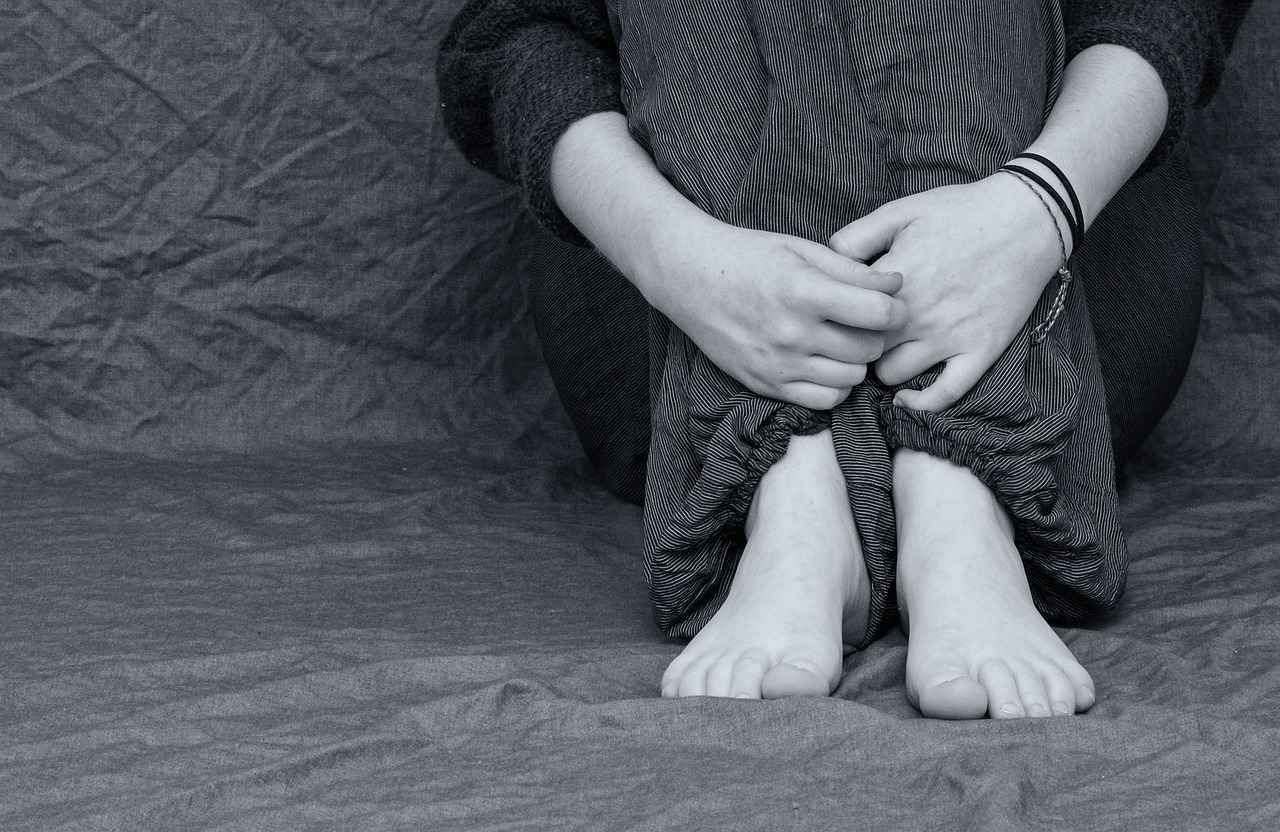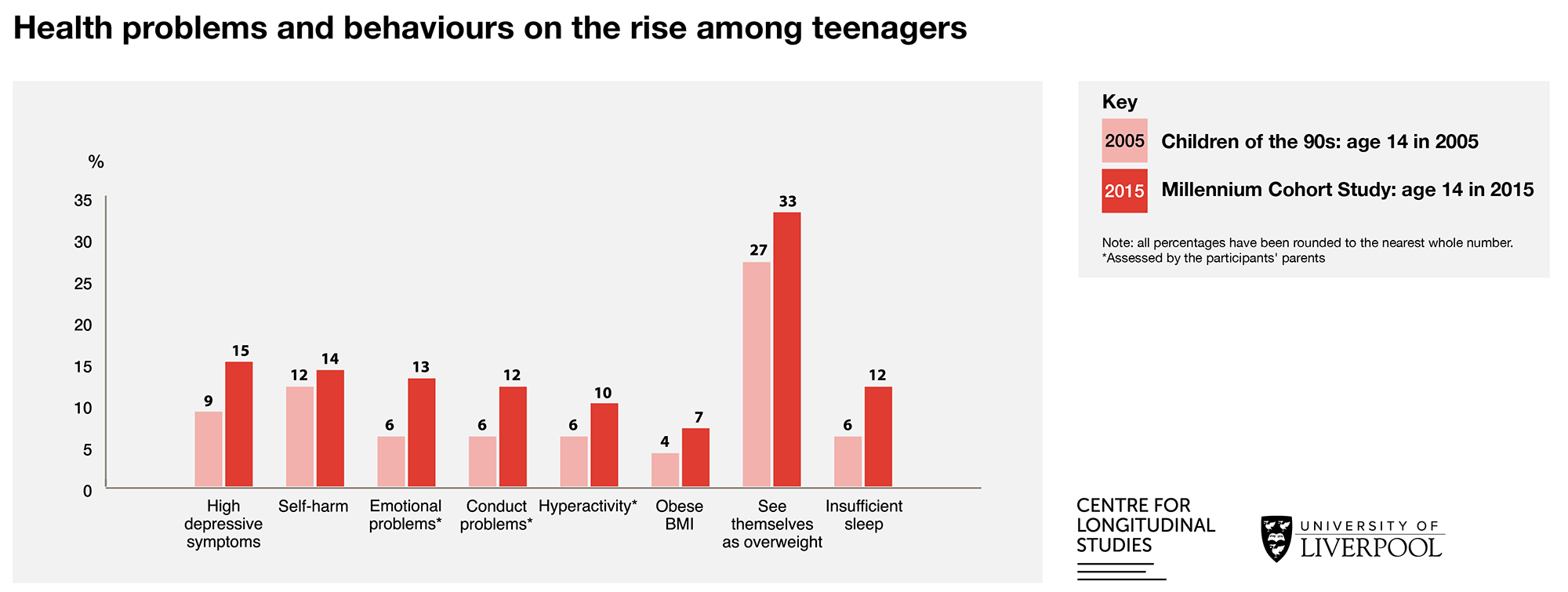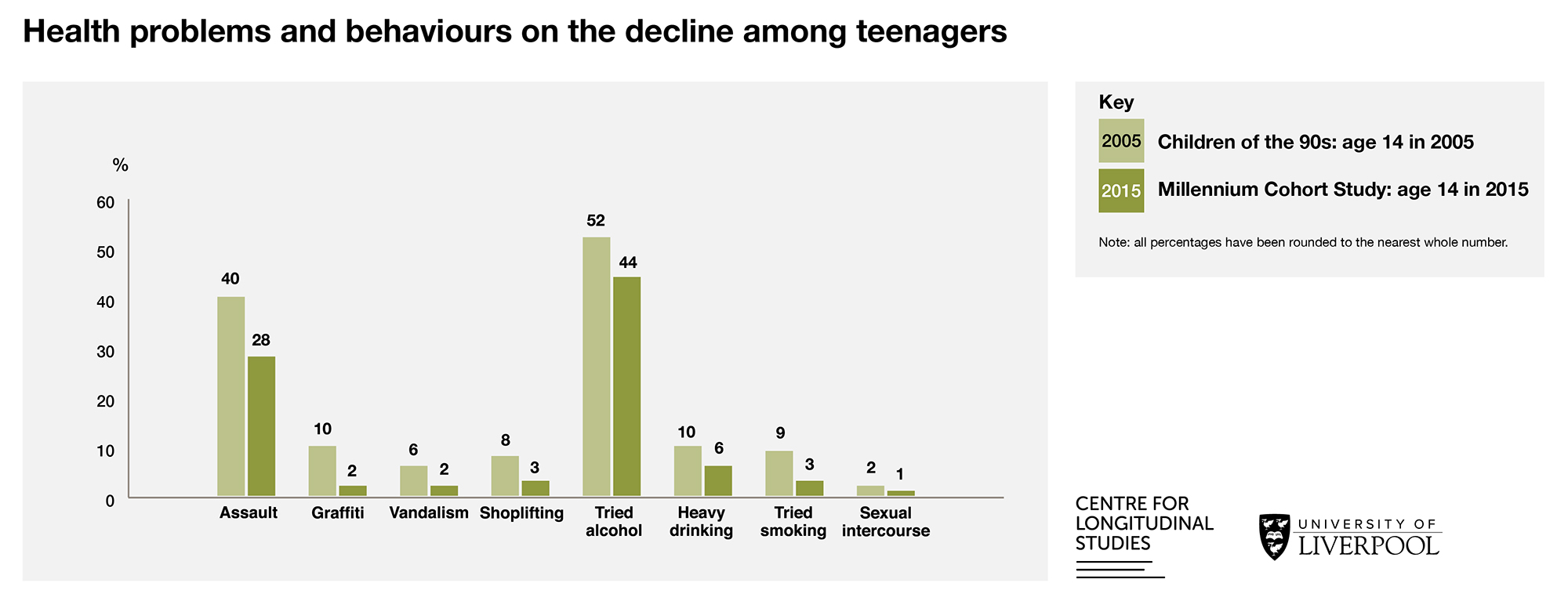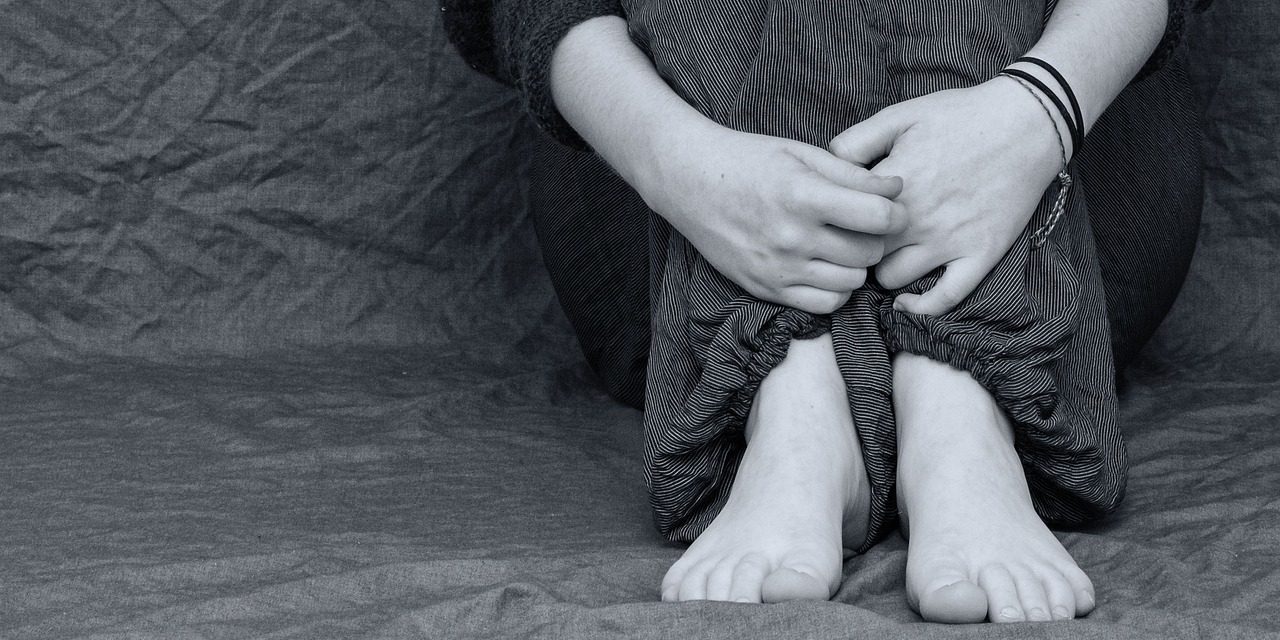The Changing Picture of Millennial Teenage Health
by Dr Praveetha Patalay and Dr Suzi GageAre there increasing levels of mental health issues amongst young people? Or is teenage angst the same as it ever was?

In the last few years the news has been filled with reports about young people’s mental health and the growing concerns around higher levels of mental health issues among young people, especially depression and self-harming. But are these levels worse than before, or are these the usual levels of teenage angst?
There have also been reports in recent years showing the falling trends in teen drinking and smoking. Other data describes reductions in sleep durations and later bedtimes, oftentimes attributed to screen-use. Examining different trends using data from different individuals with different ways of recruiting and interviewing participants makes it difficult to understand how all these things are changing relative to each other. We wanted to try and tease this out.
To do this, we analysed data on mental health and health related behaviour from adolescents aged around 14 years from two cohorts born ten years apart. The individuals in Children of the 90s were born in the early 1990s in the area surrounding Bristol, and those in the Millennium Cohort Study were born at the start of the new Millennium, and are from across the UK. To be able to make accurate comparisons first we had to create similar measures of different health behaviours and outcomes in both the cohorts. Some things like depressive symptoms were assessed using the same questionnaires in both datasets, making comparisons straightforward. Others involved some work – for example teens responded to sleep questions in one dataset with an approximate time of sleep and in the other chose a time range (e.g. 8 to 8.59), so we converted the times in the former into the same time brackets as the latter to make the data comparable. Some things we were interested in, like amount of physical activity, were so differently measured between the two datasets that we could not create a comparable enough measure, so these could not be compared in our analysis.
Once we’d selected our variables, we then had to try to account for differences between the cohorts that might make it difficult to interpret our findings; if the cohorts were different in the demographic makeup of the participants any differences seen might just be because of this, rather than representing changes over time. These differences both allude to the different regions the studies cover and also, being born ten years apart, the demographic change that has taken place in those ten years. For instance, the proportion of ethnic minority young people has increased in this decade.
(Article continues below)
The Cosmic Shambles Network relies on your support on pledges via Patreon so we can continue to provide great, new, exciting content without the need for third party ads or paywalls.
For as little as $1 a month you can support what we do and get some great rewards for doing so as well. Click the Patreon logo to pledge or find out more.
We found that depressive symptoms and self-harming behaviours did indeed increase in mid-adolescence between 2005 and 2015. After accounting for differences between the cohorts, there was over a 150% increase in young people with high depressive symptoms at age 14 years, increasing from 9% in 2005 to just under 15% in 2015. Other behaviours such as anti-social behaviours (e.g. vandalism, physical assault), trying smoking, heavy drinking and under-age sex had reduced across the same time period. For example, 6.2% of young people said they were involved in vandalism in 2005 and 2.2% in 2015. Other health outcomes had also changed. More teenagers were obese in 2015 (7.3%) compared to in 2005 (3.8%) and in parallel there was an increase in perceiving themselves as being overweight. Adolescents in 2015 were also more likely to go to sleep later and wake up earlier, with twice as many getting less than the 8 hours of recommended sleep per night in 2015 (11.5%) compared to in 2005 (5.7%). Other behaviours such as regular smoking and illicit drug use do not seem to have changed substantially in the same period – it is worth pointing out that at 14 years of age there were very low levels of illicit drug use in both cohorts.

The behaviour of adolescents is changing and understanding these changes in relation to each other instead of in isolation is important to get a full picture of adolescent health. In terms of health policy planning, these behaviours and outcomes require specialist services and health systems to suitably support young people. Understanding these changes is also relevant to future planning as mental health and health related behaviours in adolescence are not only relevant at this important life stage, but also throughout people’s lives; as they have a lifelong consequences and impacts on health and wellbeing.
While these findings might tell us a lot about what has changed in terms of mental health and health related behaviours over the past decade, they cannot tell us why these changes have occurred. Many external factors have changed over the same decade, from increased exam pressures and austerity, parents suffering from greater stress and mental health problems, social media and screen use increasing and all sorts of other factors we might not even be aware of. Understanding what has led to these changes will involve consideration of all these factors and more. It’s also important to note that while we used a number of methods to increase comparability between the two datasets we used, it’s possible that some differences between them might remain, which could bias our findings.
Our study attempted to consider adolescent health outcomes more holistically, rather than looking at each separately, in the hope that this would provide better insight into the lives of the current generation of teens in the UK. The findings highlight how much has changed in just ten years, and what has not changed, forcing us to consider the implications of changing norms, habits, behaviours and attitudes that shape the experiences of adolescents. The next steps are to understand why things are changing and how we might best support young people of today and in the future.
You can read the paper in its entirety here.
Dr Praveetha Patalay is an Associate Professor at UCL. Dr Suzi Gage is a Lecturer at the University of Liverpool, and a Wellcome Trust Engagement Fellow. They are on twitter @pravpatalay and @soozaphone

The Cosmic Shambles Network online shop has exclusive items for curious folks like yourself. Signed books, tote bags, art prints and more.
Visit the SHOP now
 Dr Suzi Gage is a a psychologist and epidemiologist lecturing in and researching recreational drugs and mental health at the University of Liverpool. Suzi is currently writing her first book, based on her award winning podcast of the same name, Say Why to Drugs. You can find her on Twitter at @soozaphone.
Dr Suzi Gage is a a psychologist and epidemiologist lecturing in and researching recreational drugs and mental health at the University of Liverpool. Suzi is currently writing her first book, based on her award winning podcast of the same name, Say Why to Drugs. You can find her on Twitter at @soozaphone.
If you would like to reuse this content please contact us for details
Subscribe to The Cosmic Shambles Network Mailing list here.



You…. you realize teenagers arent millenials correct? Lots of millenials are in their 30s now. Teenagers are in Generation Z. You’re simply making yourself look like the classic uninformed baby boomer who hates all young people but acts like it’s a generation thing. Hilarious but sad. Update the article – or dont, with such a bad title like “Millenial Teens” none of your article can be too accurate or trustworthy anyway.
HI Jess. The people who initially coined the term Millennials defined it as people who were born between the early 1980s and the early 2000s. As such, the two samples included in our study are both Millennials by that definition. And for what it’s worth, so am I.